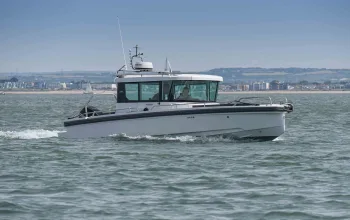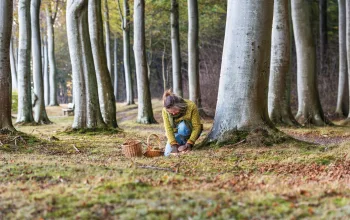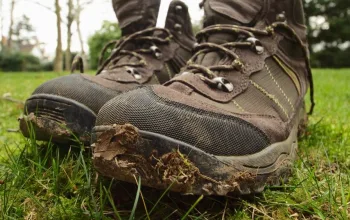Some people are natural-born climbers, and from childhood have always been climbing trees, rocks and striving to be ‘king of the castle’, while others find the whole idea vertigo-inducing. Whether you are looking to scale new heights or overcome your fears, rock climbing is all about pushing yourself physically and mentally, and the achievement of getting to the top.
It’s not all about you, though: you will need to learn how to belay for a partner. This means controlling the rope that the climber is attached to, with the help of a belay device. You take up the slack on the rope so that if your partner falls, they don’t fall too far.
In the UK there’s a wide variety of different rock surfaces for you to climb: slabs, cliffs, sea cliffs, overhangs, very technical crack climbs, and different rock types – plenty to keep the outdoor climber challenged. The best time of year to go is from spring through to autumn, but avoid the rain, as this will make handholds slippery. And if the rock is too cold, your fingers will lose their sensation.One recent convert explains. ‘It’s the physical puzzle and interaction with nature that do it for me!’ says Aynia Noever, 28, who has been climbing for 18 months.
Getting started indoors
‘Anyone can give it a go – the easiest way is to do a taster session at an indoor climbing wall,’ says Alex Messenger, of The British Mountaineering Council (BMC). Indoor climbing walls offer a secure and safe environment for taking your first steps in climbing. According to the BMC, there has only been one fatality at a climbing wall out of a total of around 50 million climbing wall users between 1960 and 2005.
Most well-used, large climbing walls will offer taster sessions, usually lasting one hour. In a taster session you might try climbing a couple of walls. A session costs between £10 and £20, and you can expect no more than four students per instructor. Equipment hire is normally provided as part of the cost of courses at climbing walls.
So a taster has given you a hunger for more. What’s next? A beginner’s course is the best way towards independent climbing without an instructor’s supervision. If you decide to take a beginner’s course, it should last approximately six hours, often broken down into two or three sessions. The group size may be six or eight pupils to one instructor, and this will cost you around £60. You will learn basic climbing technique, how to use the harness and ropes, and how to belay correctly.
After your beginner’s course you should be ready to strike out own your own with a buddy. To hire equipment, you can expect to pay a small fee for the hire of boots, around £2.50. Some centres provide harnesses, a belay device and a carabiner for free, while others charge a small amount, at most £2 for the harness and £1 for the belay and carabiner. The entry price for a practice session depends on the size of the climbing wall: small centres will charge about £5 and large ones about £10. You will also have to pay a small one-off registration fee, which is normally less then £5.
If you have climbed in the past, and want to get back into it, you will be asked by most centres to declare your competency on the registration form, to acknowledge the risks involved and your responsibility. Not many, but some centres – for example, The Castle in North London – will test your knowledge of basic knots and belaying.
There are more than 250 climbing walls in the UK, and you can find a list on the BMC website thebmc.co.uk. When choosing an indoor climbing wall, look for a member of the Association of British Climbing Walls (www.abcclimbingwalls.co.uk).
Instructors should hold qualifications, such as the Single Pitch Award (SPA), and the Mountain Instructor Award (MIA). A SPA-qualified instructor is qualified to teach climbing indoors or outdoors, but only on single-pitch routes, while the MIA-qualified instructor can teach more advanced and longer multi-pitch routes. On multi-pitch routes the ropework and risks are far more complex, as the leader must belay for the second climber before they can start to
tackle the next section.
Continued...
 From the beginning of this year, a new qualification called the Climbing Wall Award (CWA) has been in operation. The award allows instructors to teach in indoor climbing centres. See mltuk.org for more information.
From the beginning of this year, a new qualification called the Climbing Wall Award (CWA) has been in operation. The award allows instructors to teach in indoor climbing centres. See mltuk.org for more information.
Getting started outdoors
Indoor walls were originally set up as training walls for rock climbers, and as a substitute for climbing crags. Indoor walls are increasing in popularity these days, with hundreds of thousands of users each year – but the ‘real’ climbing is still to be found outdoors. ‘Staying indoors is like only ever cycling or running in the gym,’ says Dean Straw, manager of Mile End Climbing Wall, in East London.
Many of the larger indoor climbing centres, such as Mile End, Manchester Climbing Centre and Undercover Rock in Bristol, as well as many of outdoors activity centres, such as Plas Y Brenin, the National Mountain Centre in Snowdonia, Wales, all offer courses to take skills learned indoors into the countryside. These courses are commonly called ‘Touching the rock’, or ‘Inside to outside’, and last one or two days. The intention of these kinds of courses is for you to discover the differences between indoor and outdoor climbing. For example, finding hand and foot holds; to get you to understand the system of gradings used on outdoor slopes; to help you understand perceived risks, and simply to help you get to the top. Expect to pay about £100 per day, depending on group size.
In the case of children learning outdoors, check that the centre is registered with the Activities Adventure Licensing Authority (AALA) as all centres giving instruction to minors (whether by qualified instructors or not) must be licenced.
Taking climbing courses abroad can be a good way to combine a holiday and intensive instruction. Many popular climbing destinations have become more accessible with cheap flights. ‘Climbers go in search of sun and adventure in Spain, Sardinia and Majorca, just to name a few,’ says Mal Creasey of Mountain Leader Training England. Many clubs, climbing centres, and independent operators organise climbing holidays.
You will need to buy travel insurance that also covers rock climbing, and it is a good idea to have proper insurance to cover your climbing in the UK as well. BMC membership, costing around £30 per year, covers you for personal accident and civil liability insurance. Alternatively, a good way to gain more experience is to join a club. Learning from advanced climbers, enjoying climbing trips on weekends, and sharing equipment are all advantages. Membership is normally inexpensive – about £20 a year.
There are around 350 BMC-affiliated climbing clubs in Wales and England. Find a list on the BMC website to locate your nearest one. Details of clubs in Scotland and Ireland can be found at the Mountaineering Council of Scotland (www.mountaineering-scotland.org.uk) and the Mountaineering Council of Ireland (www.mountaineering.ie) respectively. Some clubs welcome beginners, and
some don’t, so get in touch with them to find out.
There is no ‘right time’ to buy your own equipment, but you should start by buying your own boots when you have decided to pursue the sport. Buy a pair suitable for beginners, for around £55. Then you will probably want to buy a chalk bag, belay device (about £20), carabiner and a harness (about £50) that fits your body shape properly. When you climb outdoors, you will need your own rope, which will cost about £80.
Another level
The next skills to learn, if you are serious about outdoor climbing, will be setting up belays on multi-pitch routes, and leading climbs. To place anchors in the rock to attach your rope while climbing is the aim of ‘Trad’ (traditional) climbing. Doing this is called ‘placing protection’, with various removable anchor systems that wedge in cracks in the rock. You need to clip on ‘quickdraws’ to the anchors to thread your rope through.
You can learn either from more experienced climbers, or by taking courses run at either indoor climbing walls or outdoors activity centres. You will also need to invest in some more sophisticated kit – called your ‘rack’. This basically consists of removable anchoring systems and ‘quickdraws’ to attach ropes to your anchor. A basic set-up will cost about £200.
Sport climbing is a fairly recent development in rock climbing, where the anchors are already bolted onto the rock face. This is popular, especially in Europe, although the US and Thailand also have great sport-climbing routes. This makes a good intermediary stage before taking on Trad climbing – although some people oppose fixing permanent bolts crags for environmental reasons.
‘Rock climbing is a multi-faceted sport,’ says Mal. As your technique and strength improve, and you can climb more difficult routes, you can branch out into different disciplines: bouldering, mountaineering, ice climbing, or even big wall climbing (where you can spend days and nights roped to a demanding, technical climb, sleeping on tiny ledges). If you want to get into competing, the best way to start is to enter competitions run by the BMC at your local climbing wall.
Ethics/conduct…
- Find out about seasonal and permanent restrictions due to bird nesting seasons and rare plant species
- Do not drop litter or leave waste. Keep the area around the crag pristine for other limbers or walkers to enjoy
- Do not leave excess chalk on rocks. Brush it away with a nylon, not wire brush, to have the minimum impact
- Walk on already-made tracks around the bottom of crags so as not to damage vegetation
- Use towels to dry holds, as using blow torches can damage the rock
How to get going…
Plas Y Brenin, the National Mountain Centre located in North Wales, runs courses over five days that could get you kick-started into a new family hobby. Children must be over the age of eight to start climbing. The course is for novices, and provides instruction on climbing techniques, tying ropes, and what equipment to use. The practice climbs are at some of Snowdonia’s renowned and glorious crags.
Web: www.pyb.co.uk





















